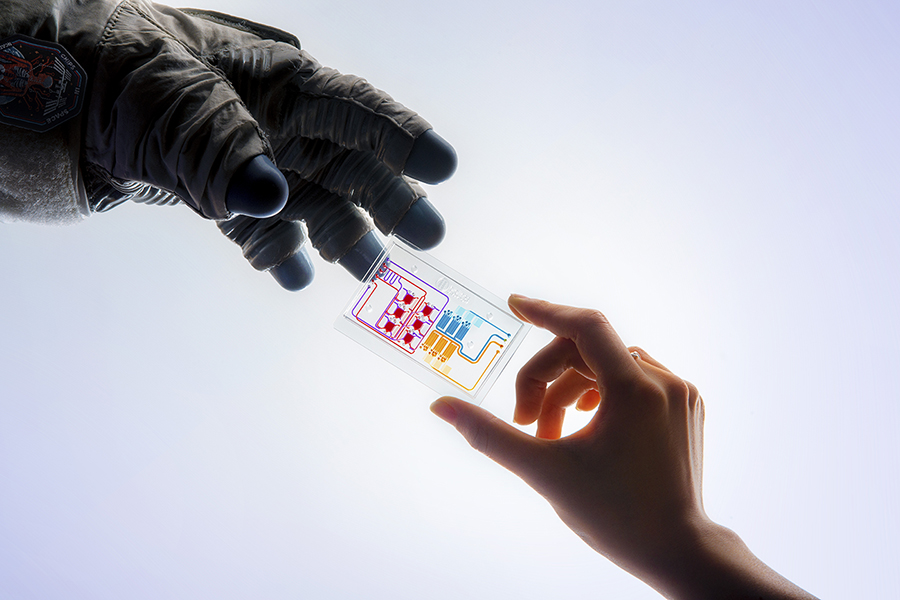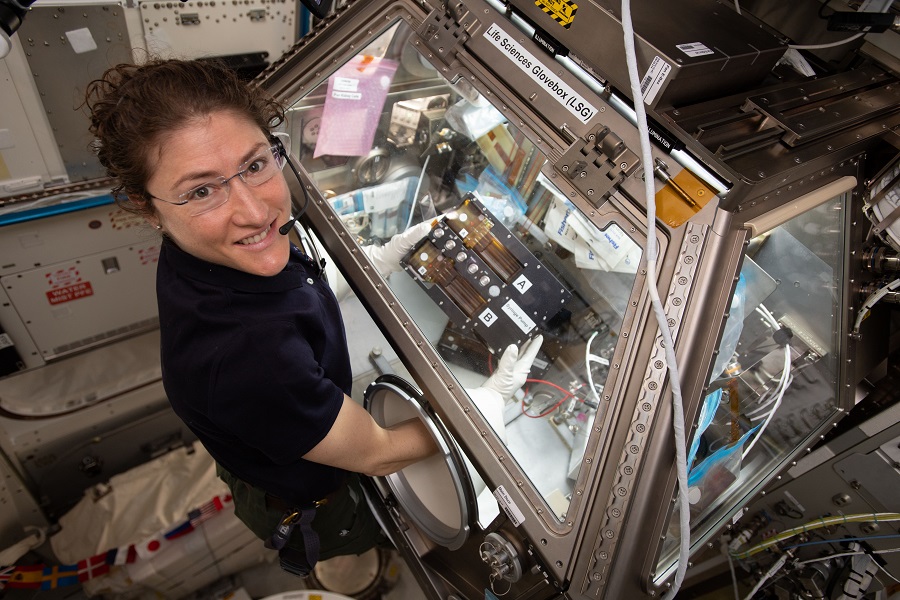NCATS-Supported Scientists Model Aging-Related Conditions in Space to Improve Human Health on Earth
Editor's Note: This announcement, which was originally posted on April 24, has been updated to reflect the May 4 launch date.
April 24, 2019
Organ-on-chip projects at the International Space Station aim to speed the development of treatments for kidney stones, arthritis and more.
NCATS-supported researchers sent four projects into space to speed both the study of aging-related conditions and the development of treatments for them. The projects, which launched May 4 to the International Space Station National Lab (ISS National Lab) on a Falcon 9 rocket from Cape Canaveral, Florida, use miniaturized tissue chip systems to mimic conditions similar to aging and certain disease states that appear to be accelerated in microgravity and provide insights that could improve human health here on Earth.
Each project is funded through the Tissue Chips in Space initiative, a collaboration among NCATS, NIH’s National Institute of Biomedical Imaging and Bioengineering and the ISS National Lab. The ISS National Lab and NASA partner to use the U.S. portion of the space station for research.
Tissue Chips in Space

A lung-bone marrow tissue chip in space will help researchers explore how the body fights infection. (Biolines Laboratory, University of Pennsylvania)
Tissue chips are tiny, complex bioengineered 3-D models that mimic the structure and function of human organ systems, such as the heart, kidneys and lungs. Scientists use tissue chips to test the potential effects of drugs on those tissues and to study diseases.
"A high percentage of candidate drugs fail in early testing in part because the models used are ineffective in predicting what will happen in patients," said NCATS director Christopher P. Austin, M.D. "Tissue chips are designed to increase efficiency, lower costs and make better predictions — and fill a gap in the translational process of turning promising compounds into approved drugs that can help people."
The unique environment of space is the key for addressing some current translational science challenges in studying disease. In just a short period of time in the reduced gravity of space, astronauts’ bodies experience certain changes. Many of these changes are similar to those that occur as we age, including altered immune systems, and loss of muscles and bones.
"Tissue chips in space provide a way to model various diseases of the aging process. Such models can be difficult or take a long time to develop here on earth but are greatly facilitated under microgravity, and scientists can use them to develop drugs that can prevent or slow down those diseases," said Danilo Tagle, Ph.D., associate director for special initiatives at NCATS. "Taking this technology into space is an unprecedented opportunity to use tissue chips for accelerating translational development of interventions for use here on earth to treat many aging-related diseases. In addition to the biological impact of the disease models, working with space payload developers speeds technological innovations, including automation and miniaturization of the instrumentations that support tissue chip technology."
Projects in Orbit

NASA astronaut Christina Koch assists with the kidney tissue chip project on board the International Space Station. (NASA)
The Tissue Chips in Space projects will test the ability of the tissue chip technology to mimic how human organs work and reveal what effects microgravity has on tissue function. Each experiment, which will have a comparable experiment in normal gravity, will have direct clinical applications to health conditions we experience on Earth.
The tissue chips on the May 4 launch to the International Space Station are:
- Lung and bone marrow chips: Scientists and engineers at Children’s Hospital of Philadelphia and the University of Pennsylvania have designed two individual tissue chips to mimic conditions in the lung and the bone marrow to understand the body’s response to infection. They will trace how the lung reacts to a bacterial infection, and separately, watch how the bone marrow turns on and mobilizes immune system cells to fight an infection. After this launch, investigators will link the bone marrow and lung systems on one chip. The work is directly relevant to how aging impacts our ability to fight infections.
- Kidney chips: University of Washington and UW Medicine researchers plan to use kidney tissue chip models to understand how microgravity affects kidney function. They hope to uncover new clues to the cause, prevention and treatment of aging-related conditions of kidney function, such as changes in vitamin D metabolism and formation of kidney stones.
- Chips modeling the blood-brain barrier: Scientists and engineers at the biotechnology company Emulate will examine the mechanics of the blood-brain barrier and what makes it more permeable under microgravity. The blood-brain barrier is key to protecting the brain from infections and toxins in the blood. New insights into how the barrier works (or malfunctions) may help in understanding and treating neurodegenerative and immune disorders.
- Bone and cartilage chips: Massachusetts Institute of Technology researchers will use a bone-cartilage model to better understand how these tissues and the immune system interact after a knee joint injury, which can lead to sometimes debilitating osteoarthritis. Their findings may help in the development of treatments, which are lacking.
On the Horizon
Each tissue chip project will fly into space twice. The initial group of tissue chips will remain on the ISS National Lab for about one month before returning to Earth. On a second mission planned for approximately 18 months later, these tissue chips will be used to test potential drug therapies on the biological processes observed during the initial mission. For example, scientists who use the bone-cartilage chip model to examine the effects of a joint injury and the accelerated development of osteoarthritis plan to use the model to test novel compounds and drugs on osteoarthritis development.
In addition to informing the development of new drugs and therapies, the projects could enable wider use of tissue chips on the ground.
"These projects illustrate a transformational acceleration in tissue chip technology that could make systems turn-key and automated, portable, and accessible to more researchers and more attractive to businesses, including pharmaceutical companies," said Lucie Low, Ph.D., scientific program manager of the NCATS Tissue Chips for Drug Screening program, which includes the Tissue Chips in Space program.
In less than two years, the scientific teams and engineers collaborated to shrink a room full of lab equipment into “plug-and-play” shoebox-sized packages that could accommodate space limitations, stand the stress of spaceflight and be operated by astronauts and pilots who don’t know the research.
This is the second time that NIH-funded tissue chip experiments have flown into space. Late last year, researchers from the University of California, San Francisco sent an experiment into orbit that examined the relationship between aging and the immune system.
"Tissue Chips in Space is an incredibly exciting program involving teamwork across scientific disciplines and federal agencies," said Low, "and I'm excited to see it take off."


